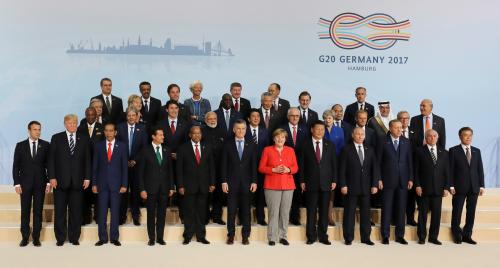Content from the Brookings Institution India Center is now archived. After seven years of an impactful partnership, as of September 11, 2020, Brookings India is now the Centre for Social and Economic Progress, an independent public policy institution based in India.
This article is a part of India 2024: Policy Priorities for the New Government, a compendium of policy briefs from scholars at Brookings India, edited by Dhruva Jaishankar and Zehra Kazmi, which identifies & addresses some of the most pressing challenges that India is likely to face in the next five years.
The South Asian neighbourhood has become a new foreign policy priority in recent years, mostly in reaction to China’s expanding footprint. In 2014, New Delhi shifted gears with its “Neighbourhood First” policy and focused more on the region than most preceding governments. However, these efforts were far too late and too little to correct decades of neglect. Beyond the “connectivity” buzzword, New Delhi’s focus on the neighbourhood has exposed tremendous capacity constraints to implement its vision on the ground. This is where India has often disappointed its neighbours and, in some cases, even paved the way for China to make further inroads. To address this competitive regional context, India should focus on the following three priorities until 2024.
Reduce the Implementation Gap
Whether it’s Neighbourhood First, Act East, or any other policy focused on regional connectivity, India will continue to under-deliver until it expands its capacity to implement. More commitments from the political leadership will further stress the already overwhelmed bureaucracy and increase the implementation gap. Nowhere was this more apparent than in 2016, when Prime Minister Narendra Modi announced BIMSTEC as a priority even as it took two years to depute an Indian director to the organisation’s secretariat. India’s failure to follow up and deliver on commitments has begun to affect its reputation. Such assessments are a liability because they perversely incentivise countries to further embrace China as an alternative.
To reduce this implementation gap in the neighbourhood, the government should first expand the Indian Foreign Service’s annual intake. It should also increase opportunities for lateral entry and outside experts to offer inputs into policymaking on economic, security and strategic affairs relating to the neighbourhood. Secondly, it should incentivise coordination and cross-posting of officials between the Ministry of External Affairs (MEA) and other ministries invested in regional connectivity. MEA’s role as an international gatekeeper and its discretion to veto international engagement by other ministries, the armed forces and state governments should be reduced. Third, the Prime Minister should appoint a cabinet-ranked Special Envoy on regional connectivity, with political clout to reach out directly to heads of government and key political actors in neighbouring countries. This envoy should not override, but complement bureaucratic inputs and formal bilateral channels. Finally, the government should implement the Special Purpose Vehicle/Facility (announced in 2014) to accelerate regional infrastructure projects. It should reduce dependency on public sector unit (PSU) adjudication to implement projects and, instead, privilege open-tender processes for Indian and international private companies.
Lead by Example and Asymmetry
As the subcontinent’s predominant power, India’s investment in regional connectivity will only succeed if it leads by example and opens up first to its smaller neighbours. Such asymmetric advantages, popularly coined as the “Gujral doctrine” in the 1990s, should not be seen as a mere expression of altruism or generosity. As Prime Minister Manmohan Singh emphasised in 2010, India should engage its neighbours “without looking at reciprocity, [but] in our own enlightened interest.” The pursuit of India’s domestic interests hinges increasingly on greater regional interdependence.
India’s investment in connectivity requires a dual focus at home and abroad. Internally, greater openness will require skill to convince (or coerce) domestic opposition groups and absorb the political costs of asymmetric advantages to neighbouring countries. Externally, greater connectivity will also require skill to assuage neighbouring countries’ fears about excessive reliance on India, or being overwhelmed by its economic and demographic pressures. Tactical concessions to neighbours will pay off in the long-term by generating trust through non-reciprocal openings.
This requires the following steps based on positive discrimination. First, India should eliminate all forms of bureaucratic, tariff, security and any other barriers to land-based trade and transportation between Nepal, Bhutan, and Bangladesh through Indian territory. Second, it should offer neighbours duty-free access to Indian railways and ports, as well as new air transport corridors to fly to/across Indian airspace. It should also revise visa policies to offer citizens from neighbouring countries privileged access to India. It makes little sense that an American or Chinese finds it easier to visit India than a citizen from neighbouring Bangladesh or Myanmar. Third, it should modernise border control infrastructure and facilitate cross-border flows through further expansion of Integrated Check Posts. This would benefit from the creation of a smart identification system that formalises border crossings between India and Nepal, as requested by Kathmandu. Finally, India should gradually eliminate all goods remaining on its sensitive trade lists in South Asia, while also supporting Bangladesh and Nepal’s demands to remain in the “least developed” category at multilateral trade and lending organisations.
Regain the Initiative
China is now a resident power in South Asia and has ended India’s quasi-monopoly of influence in the region. China is now one of the main players in supporting infrastructure modernisation and developmental initiatives in India’s periphery – whether its optic fibre or rail links connecting Nepal across the Himalayas; the 99-year lease of the Hambantota port in Sri Lanka; or its shareholding in the Dhaka Stock Exchange. Students, journalists, and even government or military officials from across the region now actively look to China for professional or training opportunities. Naturally, this entanglement has also increased Beijing’s strategic leverage to influence the domestic politics and foreign policy of these countries despite their “India first” proclamations.
While adjusting to this new reality, India has sometimes oscillated between the extremes of complacency (hopeful inaction, waiting for Chinese initiative to fizzle out) and overreaction (obsessive obstruction of Chinese initiatives as security threats). Beyond such short-termism, New Delhi must invest in ways that can shape neighbouring countries’ long-term incentive structures to favour India. This will require more focus on grants and loans for infrastructure development towards capacity-building programs (through the Development Partnership Administration and Indian Technical and Economic Cooperation) that increase technical self-sufficiency and institutional resilience in neighbouring countries. Let China pay for hard connectivity, and instead, India can explore its comparative advantage in soft connectivity and democratic governance. Secondly, India should increase resources for public diplomacy and outreach initiatives that target the new generation of political leaders, entrepreneurs, and scholars in neighbouring countries. Increasingly lured to Shanghai or New York, they need to find greater exposure and opportunities to also grow in New Delhi or Mumbai. Third, India should consolidate the variety of new trilateral connectivity and infrastructure initiatives by focusing on sequencing and flagship projects. One finalised India-Japan third-country project in Sri Lanka, for example, will be better than twelve under completion. Finally, India should de-hyphenate its Pakistan and SAARC policies. It should sustain a variety of regional cooperation initiatives, including BIMSTEC and BBIN, but also recommit to SAARC.




Commentary
India 2024: A neighbourly India
May 17, 2019